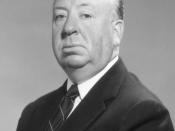Alfred Hitchcock uses many ways to explore the duality of human nature in his films, especially in the 1960 horror thriller Psycho. The duality of human nature represents our inner self, aspects that are mainly opposites, the light showing good, the dark showing evil, the natural and the unnatural, are just some examples of human nature. Hitchcock explored the duality of human nature using ways such as lighting, dialogue, camera angles, music, comparing and contrasting what different characters would do when facing the same problem and individuation. According to Carl Jung, individuation is when a person confronts they inner side (usually the dark, negative and evil side). He believed that successful individuation meant that a person not only confronted their dark side, but conquered it as well and that people needed to recognise and confront the negative aspects of their personality or their "dark" side would destroy the person. This means that inside everyone, there is a darker side, an evil and bad side, that must be confronted, or it will ruin you.
By looking at the two main characters Norman and Marion, and two minor characters, Sam and Lila, we can see the duality of human nature. Both Marion and Norman are being confronted with their inner dark self, yet, Marion conquers her dark side, while Norman lets it take over his life. Sam and Lila, however, are mostly seen as good and "natural".
There are many key scenes throughout the movie Physco, which explore the duality of human nature. Some of these scenes include the opening scene, the scene in which Marion is driving away after taking the money and the parlour scene.
The blackness of Psycho's opening credits sequence symbolizes death and the opening scene of Psycho starts with a pan view of the cityscape of Arizona.


